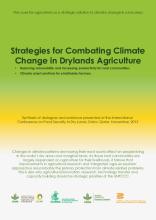/ library resources
Showing items 1 through 9 of 217.The figures of public resources estimated to have been channeled into private pockets are so high one hopes, obviously against hope, that they would turn out to be typographical errors.
This analysis and recommendations stem from USAID/Kenya’s request for an assessment of Kenya’s draft National Land Policy (dNLP).4 It was conducted under the global task order: Property Rights and Resource Governance Program, a mechanism designed and supervised by USAID-EGAT’s Land Resources Mana
Synthesis of dialogues and evidence presented at the International Conference on Food Security in Dry Lands, Doha, Qatar, November, 2012
This report suggests that a new and explicit goal of sustainable development to be agreed as a result of Rio+20 should be the reduction of the rate of land degradation to achieve land degradation neutrality, which we refer to as “Zero Net Land Degradation” or ZNLD.
Constrained access to land is increasingly recognized as a problem impeding rural household welfare in densely populated areas of Africa. This study utilizes household and parcel level data from rural Kenya to explore the linkage between land access and food security.
The 2014 Global Hunger Index (GHI) report—the ninth in an annual series—presents a multidimensional measure of national, regional, and global hunger.
In recent years, prices of agricultural land have increased quickly, actually doubling and tripling in many parts of the world. This land value reassessment has been prompted by rising crop prices and perceived land scarcity.
Der Welthunger-Index (WHI) 2014 stellt die nationale, regionale und weltweite Hungersituation zum neunten Mal in jahrlicher Folge multidimensional dar.
Paginação
Land Library Search
Through our robust search engine, you can search for any item of the over 73,000 highly curated resources in the Land Library.
If you would like to find an overview of what is possible, feel free to peruse the Search Guide.







